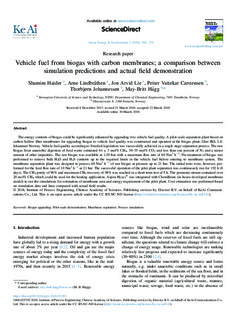| dc.contributor.author | Haider, Shamim | |
| dc.contributor.author | Lindbråthen, Arne | |
| dc.contributor.author | Lie, Jon Arvid | |
| dc.contributor.author | Carstensen, Petter Vattekar | |
| dc.contributor.author | Johannessen, Thorbjørn | |
| dc.contributor.author | Hagg, May-Britt | |
| dc.date.accessioned | 2018-08-15T12:05:43Z | |
| dc.date.available | 2018-08-15T12:05:43Z | |
| dc.date.created | 2018-05-22T09:23:53Z | |
| dc.date.issued | 2018 | |
| dc.identifier.issn | 2468-0257 | |
| dc.identifier.uri | http://hdl.handle.net/11250/2558149 | |
| dc.description.abstract | The energy contents of biogas could be significantly enhanced by upgrading it to vehicle fuel quality. A pilot-scale separation plant based on carbon hollow fiber membranes for upgrading biogas to vehicle fuel quality was constructed and operated at the biogas plant, Glør IKS, Lillehammer Norway. Vehicle fuel quality according to Swedish legislation was successfully achieved in a single stage separation process. The raw biogas from anaerobic digestion of food waste contained 64 ± 3 mol% CH4, 30–35 mol% CO2 and less than one percent of N2 and a minor amount of other impurities. The raw biogas was available at 1.03 bar with a maximum flow rate of 60 Nm3 h−1. Pre-treatment of biogas was performed to remove bulk H2O and H2S contents up to the required limits in the vehicle fuel before entering to membrane system. The membrane separation plant was designed to process 60 Nm3 h−1 of raw biogas at pressure up to 21 bar. The initial tests were, however, performed for the feed flow rate of 10 Nm3 h−1 at 21 bar. The successful operation of the pilot plant separation was continuously run for 192 h (8 days). The CH4 purity of 96% and maximum CH4 recovery of 98% was reached in a short-term test of 5 h. The permeate stream contained over 20 mol% CH4 which could be used for the heating application. Aspen Hysys® was integrated with ChemBrane (in-house developed membrane model) to run the simulations for estimation of membrane area and energy requirement of the pilot plant. Cost estimation was performed based on simulation data and later compared with actual field results. | nb_NO |
| dc.language.iso | eng | nb_NO |
| dc.publisher | Elsevier | nb_NO |
| dc.rights | Attribution-NonCommercial-NoDerivatives 4.0 Internasjonal | * |
| dc.rights.uri | http://creativecommons.org/licenses/by-nc-nd/4.0/deed.no | * |
| dc.title | Vehicle fuel from biogas with carbon membranes; a comparison between simulation predictions and actual field demonstration | nb_NO |
| dc.type | Journal article | nb_NO |
| dc.type | Peer reviewed | nb_NO |
| dc.description.version | publishedVersion | nb_NO |
| dc.source.journal | Green Energy & Environment | nb_NO |
| dc.identifier.doi | https://doi.org/10.1016/j.gee.2018.03.003 | |
| dc.identifier.cristin | 1585812 | |
| dc.description.localcode | © 2018, Institute of Process Engineering, Chinese Academy of Sciences. Publishing services by Elsevier B.V. on behalf of KeAi Communications Co.,Ltd. This is an open access article under the CC BY-NC-ND license (http://creativecommons.org/licenses/by-nc-nd/4.0/) | nb_NO |
| cristin.unitcode | 194,66,30,0 | |
| cristin.unitname | Institutt for kjemisk prosessteknologi | |
| cristin.ispublished | false | |
| cristin.fulltext | original | |
| cristin.qualitycode | 1 | |

